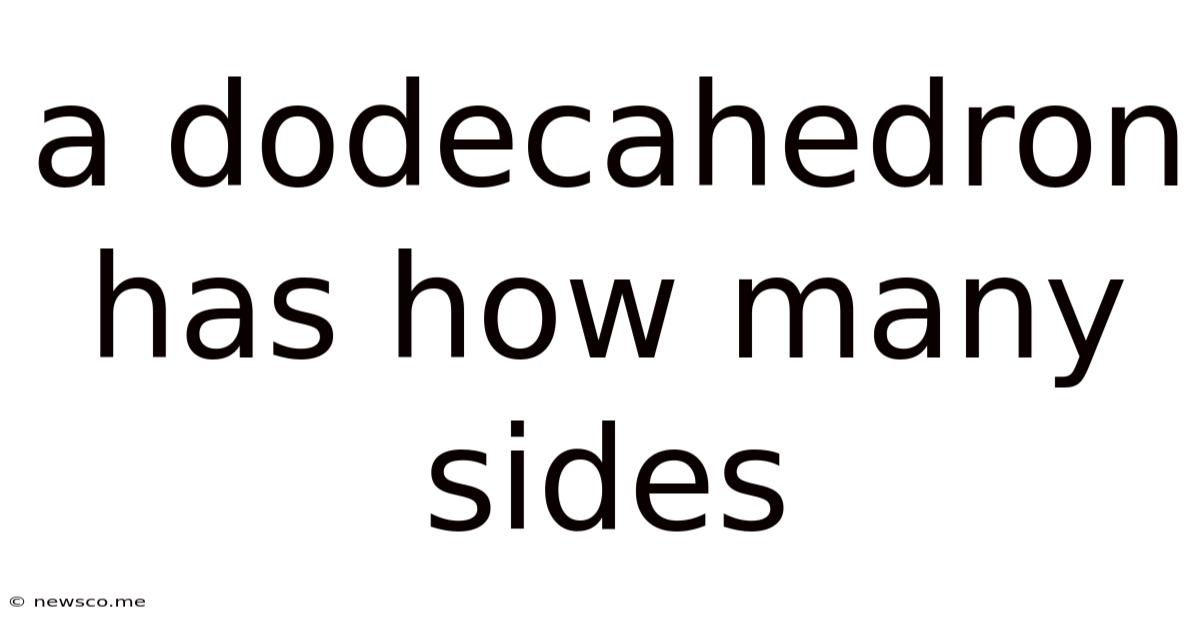A Dodecahedron Has How Many Sides
News Co
Apr 21, 2025 · 5 min read

Table of Contents
A Dodecahedron: Unveiling the Mysteries of its 12 Sides (and Much More!)
The dodecahedron, a captivating three-dimensional shape, often evokes a sense of intrigue and mathematical wonder. But for many, the very question of how many sides a dodecahedron possesses can be a starting point for a deeper dive into the world of geometry and polyhedra. This comprehensive guide will not only answer that question definitively but will also explore the fascinating properties and characteristics of this remarkable geometric solid. Prepare to be amazed!
Understanding the Basics: What is a Dodecahedron?
A dodecahedron is a three-dimensional shape, or polyhedron, with twelve faces. Each of these faces is a regular pentagon—a five-sided polygon with all sides and angles equal. This uniformity makes the dodecahedron a member of the Platonic solids, a highly exclusive club of just five regular convex polyhedra. The other members of this elite group are the tetrahedron (4 faces), cube (6 faces), octahedron (8 faces), and icosahedron (20 faces). Their inherent symmetry and mathematical elegance have captivated mathematicians and philosophers for millennia.
Answering the Core Question: How Many Sides Does a Dodecahedron Have?
The simple answer is twelve. A dodecahedron has twelve pentagonal faces. However, the question itself reveals a common misunderstanding about geometric terminology. While we often use "sides" informally to refer to the faces of a three-dimensional shape, the term "side" in geometry more accurately refers to the edges of a polygon or polyhedron.
Sides vs. Faces: Clearing Up the Confusion
To avoid ambiguity, it's crucial to distinguish between faces, edges, and vertices of a polyhedron.
- Faces: These are the flat surfaces that make up the polyhedron. In a dodecahedron, these are the twelve pentagons.
- Edges: These are the line segments where two faces meet.
- Vertices: These are the points where three or more edges intersect.
Therefore, while a dodecahedron has twelve faces, it's more precise to refer to the number of its faces rather than sides when describing its fundamental properties.
Beyond the Sides: Exploring the Properties of a Dodecahedron
The dodecahedron's twelve pentagonal faces are just the beginning of its mathematical richness. Let's delve into some of its key characteristics:
1. Number of Edges:
A dodecahedron has 30 edges. Each pentagonal face has five edges, and since there are twelve faces, a simple calculation (12 faces * 5 edges/face) reveals the total number of edges. However, each edge is shared by two faces, which is why the total number of edges is less than the total number of edges on all the faces taken individually.
2. Number of Vertices:
The dodecahedron boasts 20 vertices. At each vertex, three pentagonal faces meet.
3. Symmetry and Rotational Symmetry:
The dodecahedron possesses a high degree of symmetry. It has numerous planes of symmetry, axes of symmetry, and rotational symmetries. This exceptional symmetry contributes to its aesthetic appeal and mathematical significance. Its rotational symmetry allows it to be rotated in various ways while still appearing identical. This inherent symmetry is a defining characteristic of the Platonic solids.
4. Dual Polyhedron:
Every Platonic solid has a dual, which is another Platonic solid formed by connecting the centers of adjacent faces of the original solid. The dual of the dodecahedron is the icosahedron. This reciprocal relationship underscores the profound interconnectedness within the family of Platonic solids.
5. Stellations:
The dodecahedron can be "stellated," meaning that its faces can be extended to create a new, more complex polyhedron. This process generates a fascinating array of stellated dodecahedra, each with its unique beauty and mathematical properties. These stellations often appear far more intricate than the original dodecahedron.
6. Applications in Art and Architecture:
The dodecahedron’s striking symmetry and visual appeal have inspired artists and architects for centuries. Its form can be found in various works of art, architectural designs, and even in some naturally occurring structures. The inherent balance and elegance of the dodecahedron's shape make it a visually captivating element in design.
7. Mathematical Significance and Euler's Formula:
The dodecahedron perfectly illustrates Euler's formula, a fundamental theorem in topology: V - E + F = 2, where V is the number of vertices, E is the number of edges, and F is the number of faces. For a dodecahedron, this translates to 20 - 30 + 12 = 2, confirming the validity of the formula for this Platonic solid. This formula applies to all convex polyhedra, solidifying the dodecahedron’s place within a broader mathematical context.
Beyond the Regular Dodecahedron: Exploring Variations
While the regular dodecahedron, with its twelve congruent pentagonal faces, holds a special place in geometry, there are also various irregular dodecahedra. These variations may have twelve faces, but they won't all be regular pentagons. Some may have differently shaped faces, or faces with different sizes. The mathematical properties of these irregular dodecahedra can differ significantly from the regular counterpart.
Conclusion: The Enduring Allure of the Dodecahedron
The seemingly simple question, "How many sides does a dodecahedron have?", opens the door to a rich and fascinating world of geometric exploration. While the answer—twelve faces—is straightforward, the deeper understanding of the dodecahedron's properties reveals its remarkable complexity and mathematical elegance. From its symmetry and dual relationship with the icosahedron to its applications in art and its place within Euler's formula, the dodecahedron continues to captivate mathematicians, artists, and anyone with an appreciation for the beauty of geometry. Its twelve faces serve as a gateway to a much larger and more intricate mathematical landscape. So, next time you encounter this fascinating polyhedron, remember its twelve faces and the wealth of mathematical wonders they represent.
Latest Posts
Related Post
Thank you for visiting our website which covers about A Dodecahedron Has How Many Sides . We hope the information provided has been useful to you. Feel free to contact us if you have any questions or need further assistance. See you next time and don't miss to bookmark.